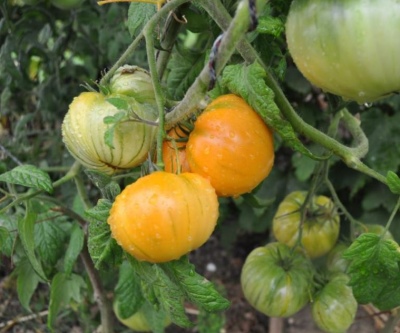
- Authors: USA
- Name synonyms: Pineapple Gold, Ananas Gold, Golden Pineapple
- Category: grade
- Growth type: indeterminate
- Appointment: universal
- Ripening period: mid-season
- Ripening time, days: 105-110
- Growing conditions: for open ground, for greenhouses
- Bush size: tall
- Bush height, cm: up to 200
The American Golden Pineapple variety, also known as Ananas Gold, Golden Pineapple, is one of the most popular yellow-fruited tomato varieties. It is appreciated for its easy adaptation to growing conditions, large and beautiful fruits, excellent taste. This variety managed to enter the golden collection of plants around the world.
Description of the variety
Indeterminate variety gives tall shoots up to 200 cm. Leaves are simple, there are not too many of them. The stem is powerful, well developed.
The main qualities of the fruit
Tomatoes of this variety are very attractive, when ripe they are bright orange, with pink rays on the cap. The shape of the fruits is flat-round, the average weight of each reaches 400-600 g. Even on the upper branches, the tomatoes are large. The pulp is orange-pink, with small seed chambers inside.
Taste characteristics
The fruits are sweet, with a slight sourness and juicy pulp. They are excellent fresh and have a light fruity flavor.
Ripening and fruiting
The tomatoes are mid-ripening, with long-term fruiting. The ripening period is 105-110 days. All fruits have time to ripen by the end of the season.
Yield
The volume of fruit collection from each bush in the greenhouse reaches 4-5 kg. In the open field, the indicators are more modest. The Golden Pineapple variety is considered to be a high-yielding variety.
The timing of planting seedlings and planting in the ground
Sowing seeds of tomatoes of this variety is carried out from the 3rd decade of February to mid-March. In the south, it is possible to plant directly into the greenhouse, in other regions, a seedling method of obtaining material is used. It is necessary to deepen the seeds by no more than 10-30 mm. Young bushes are transferred to open ground no earlier than the end of April.

Growing tomato seedlings is an extremely important process, because it largely depends on whether the gardener can harvest at all. All aspects must be taken into account, from seedbed preparation to planting in the ground.
Landing scheme
There should be 2-3 bushes per 1 m2.

Growing and caring
Bushes with long stems need to form 2 shoots. This will provide the highest fruiting intensity. Planting on ridges and in the greenhouse is done sparsely to avoid over-thickening. This will allow the fruit to ripen in the sun on both the lower and upper branches. If the crown thickens, it is thinned out.
The garter of tomato bushes is also required, otherwise the shoots may simply break under the weight of the fruit brushes. The supports are needed high, as the number of garter points increases as they grow. Once every 10-14 days, pinching of the bush is performed.It will help keep the plant strong for setting fruit, and reduce the risk of developing fungal diseases in the root area.
The correct growth and development of tomatoes is largely determined by the quality of plant care. Humus and other organic matter are good fertilizers for this variety. It is laid in the soil when planting and then added when loosening. Ready-made mixtures can become an alternative to natural dressing. From the moment the ovaries form on the bushes, plants are given complex fertilizing containing potassium and phosphorus.




A plant needs different micronutrients at each stage of growth. All fertilizers can be divided into two groups: mineral and organic. Folk remedies are often used: iodine, yeast, bird droppings, eggshells.
It is important to observe the rate and period of feeding. This also applies to folk remedies and organic fertilizers.
Disease and pest resistance
The variety is practically not affected by diseases and pests. Resistant to most fungal and viral infections of nightshade crops.


Resistant to adverse weather conditions
Tomato is not too capricious in the choice of growing conditions, but its cold resistance is still not high enough for the northern regions. Bushes are sensitive to the amount of light, need an abundance of sun, during prolonged periods of cloudy weather, they can reduce fruit set.
Review overview
Many summer residents dream of planting Golden Pineapple tomatoes on their site. The variety attracts attention with its unusualness, does not disappoint with its germination rates - over 80%, which is not bad at all for an exotic plant. According to summer residents, Golden pineapple grows best in greenhouses, quickly gains a significant stem height, bears fruit almost to frost. The variety is well suited even for novice vegetable growers, responds to regular watering and feeding, pinching with amicable and abundant ripening of tomatoes on the branches.
The taste of the fruit is also admirable. Unusual pineapple notes are felt very vividly here. Fleshy and juicy flesh decorates salads, sandwiches, but tomatoes are not suitable for whole-fruit canning or processing. And also tomatoes are poorly stored, it will not work to stock them for the winter.

























































































